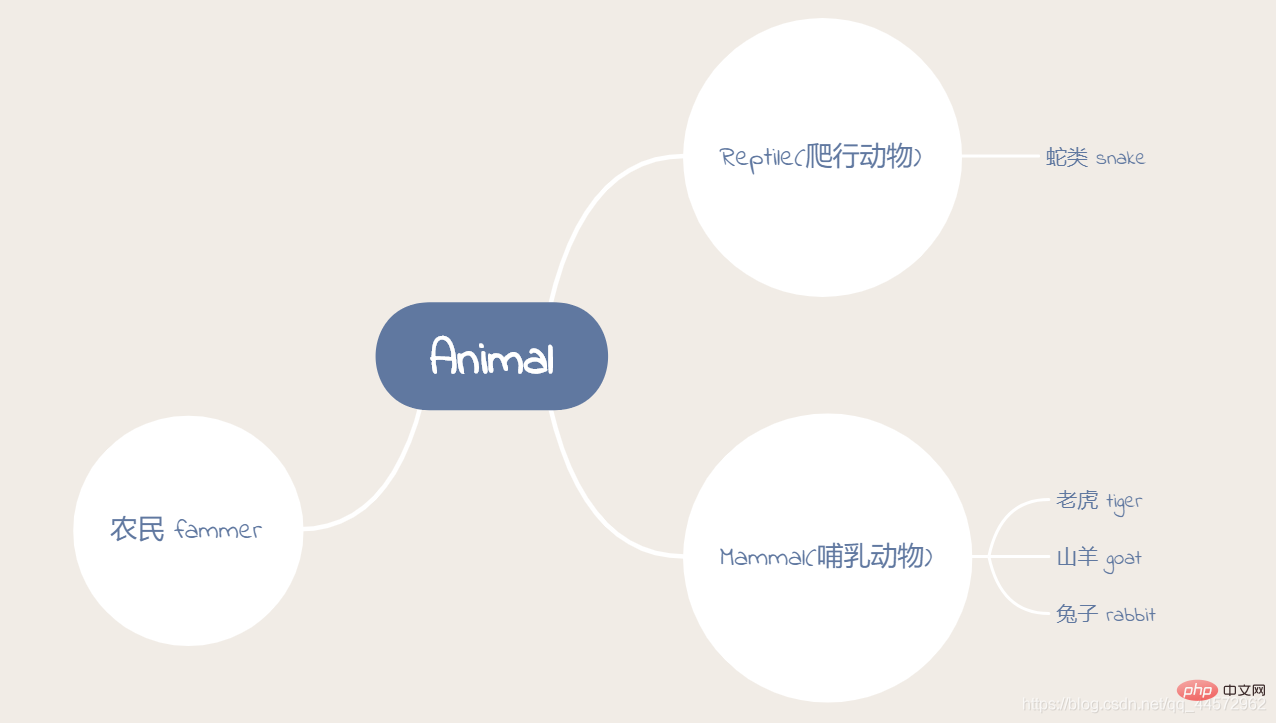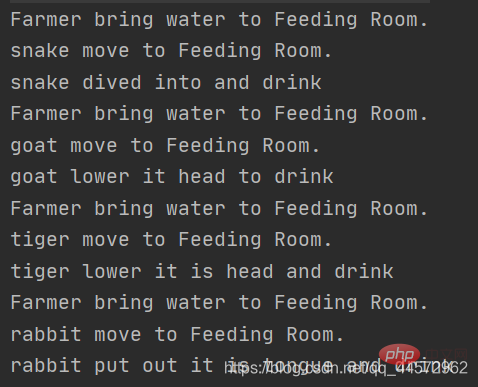Example analysis of Java abstract definition
1. Overview
In the concept of OOP, all objects are described through classes; but not all classes are used to describe objects. If a class does not contain enough information to describe a concrete object, such a class is called an abstract class.
Abstract class: (1) Abstract classes cannot instantiate objects. If an object is instantiated, compilation will not pass. Only non-abstract subclasses of abstract classes can create objects (2) that can include: member variables, member methods, constructors, etc. (3) Constructors and class methods (methods modified with static) cannot be declared as abstract methods
Abstract methods: (1) If a class contains an abstract method, then the class must be an abstract class (2) Any The subclass must override the abstract method of the parent class, or declare itself as an abstract class
Definition: abstract class Class name
2. Example: Farmers feeding animals
Animal: Abstract class--------getName(), move(), drink()
Reptile, Mammal: inherit abstract class
Snake, tiger, goat, rabbit: inherit respectively Reptile or Mammal
fammer:bringWater(), feedWater(Animal animal)---- Responsible for bringing water to the designated place, and then the animal moves to the destination and drinks water

The code is as follows:
package abstractDemo;
/**
* @author lpx
* @Description TODO
* @date 2021-04-07
*/
public abstract class Animal {
abstract String getName();
abstract void move(String destination);
abstract void drink();
}
abstract class Reptile extends Animal{
}
abstract class Mammal extends Animal{
}
class Tiger extends Mammal{
private static String name="tiger";
@Override
String getName() {
return this.name;
}
@Override
void move(String destination) {
System.out.println("tiger move to "+destination+".");
}
@Override
void drink() {
System.out.println("tiger lower it is head and drink");
}
}
class Goat extends Mammal{
private static String name="goat";
@Override
String getName() {
return this.name;
}
@Override
void move(String destination) {
System.out.println("goat move to "+destination+".");
}
@Override
void drink() {
System.out.println("goat lower it head to drink");
}
}
class Rabbit extends Mammal{
private static String name="rabbit";
@Override
String getName() {
return this.name;
}
@Override
void move(String destination) {
System.out.println("rabbit move to "+destination+".");
}
@Override
void drink() {
System.out.println("rabbit put out it is tongue and drink");
}
}
class Snake extends Reptile{
private static String name="snake";
@Override
String getName() {
return this.name;
}
@Override
void move(String destination) {
System.out.println("snake move to "+destination+".");
}
@Override
void drink() {
System.out.println("snake dived into and drink");
}
}
class Farmer{
public void bringWater(String destination){
System.out.println("Farmer bring water to " + destination + ".");
}
public void feedWater(Animal a){ // polymorphism
this.bringWater("Feeding Room");
a.move("Feeding Room");
a.drink();
}
}
class Test{
public static void main(String[] args) {
Farmer fm=new Farmer();
Snake snake=new Snake();
Goat goat=new Goat();
Tiger tiger=new Tiger();
Rabbit rabbit=new Rabbit();
fm.feedWater(snake);
fm.feedWater(goat);
fm.feedWater(tiger);
fm.feedWater(rabbit);
}
}Execution results:

package abstractDemo;
/**
* @author lpx
* @Description TODO
* @date 2021-04-07
*/
class Tiger1{
private static String name="tiger";
String getName() {
return this.name;
}
void move(String destination) {
System.out.println("tiger move to "+destination+".");
}
void drink() {
System.out.println("tiger lower it is head and drink");
}
}
class Goat1{
private static String name="goat";
String getName() {
return this.name;
}
void move(String destination) {
System.out.println("goat move to "+destination+".");
}
void drink() {
System.out.println("goat lower it head to drink");
}
}
class Rabbit1{
private static String name="rabbit";
String getName() {
return this.name;
}
void move(String destination) {
System.out.println("rabbit move to "+destination+".");
}
void drink() {
System.out.println("rabbit put out it is tongue and drink");
}
}
class Farmer1{
public void bringWater(String destination){
System.out.println("Farmer bring water to " + destination + ".");
}
public void feedWater(Goat1 goat){ // polymorphism
this.bringWater("Feeding Room");
goat.move("Feeding Room");
goat.drink();
}
public void feedWater(Tiger1 tiger){ // polymorphism
this.bringWater("Feeding Room");
tiger.move("Feeding Room");
tiger.drink();
}
public void feedWater(Rabbit1 rabbit1) {
this.bringWater("Feeding Room");
rabbit1.move("Feeding Room");
rabbit1.drink();
}
}
public class Test1{
public static void main(String[] args) {
Farmer1 farmer1=new Farmer1();
Tiger1 tiger1=new Tiger1();
Goat1 goat1=new Goat1();
Rabbit1 rabbit1=new Rabbit1();
farmer1.feedWater(tiger1);
farmer1.feedWater(goat1);
farmer1.feedWater(rabbit1);
}
}The above is the detailed content of Example analysis of Java abstract definition. For more information, please follow other related articles on the PHP Chinese website!

Hot AI Tools

Undresser.AI Undress
AI-powered app for creating realistic nude photos

AI Clothes Remover
Online AI tool for removing clothes from photos.

Undress AI Tool
Undress images for free

Clothoff.io
AI clothes remover

Video Face Swap
Swap faces in any video effortlessly with our completely free AI face swap tool!

Hot Article

Hot Tools

Notepad++7.3.1
Easy-to-use and free code editor

SublimeText3 Chinese version
Chinese version, very easy to use

Zend Studio 13.0.1
Powerful PHP integrated development environment

Dreamweaver CS6
Visual web development tools

SublimeText3 Mac version
God-level code editing software (SublimeText3)

Hot Topics
 1665
1665
 14
14
 1423
1423
 52
52
 1321
1321
 25
25
 1269
1269
 29
29
 1249
1249
 24
24
 Break or return from Java 8 stream forEach?
Feb 07, 2025 pm 12:09 PM
Break or return from Java 8 stream forEach?
Feb 07, 2025 pm 12:09 PM
Java 8 introduces the Stream API, providing a powerful and expressive way to process data collections. However, a common question when using Stream is: How to break or return from a forEach operation? Traditional loops allow for early interruption or return, but Stream's forEach method does not directly support this method. This article will explain the reasons and explore alternative methods for implementing premature termination in Stream processing systems. Further reading: Java Stream API improvements Understand Stream forEach The forEach method is a terminal operation that performs one operation on each element in the Stream. Its design intention is
 PHP: A Key Language for Web Development
Apr 13, 2025 am 12:08 AM
PHP: A Key Language for Web Development
Apr 13, 2025 am 12:08 AM
PHP is a scripting language widely used on the server side, especially suitable for web development. 1.PHP can embed HTML, process HTTP requests and responses, and supports a variety of databases. 2.PHP is used to generate dynamic web content, process form data, access databases, etc., with strong community support and open source resources. 3. PHP is an interpreted language, and the execution process includes lexical analysis, grammatical analysis, compilation and execution. 4.PHP can be combined with MySQL for advanced applications such as user registration systems. 5. When debugging PHP, you can use functions such as error_reporting() and var_dump(). 6. Optimize PHP code to use caching mechanisms, optimize database queries and use built-in functions. 7
 PHP vs. Python: Understanding the Differences
Apr 11, 2025 am 12:15 AM
PHP vs. Python: Understanding the Differences
Apr 11, 2025 am 12:15 AM
PHP and Python each have their own advantages, and the choice should be based on project requirements. 1.PHP is suitable for web development, with simple syntax and high execution efficiency. 2. Python is suitable for data science and machine learning, with concise syntax and rich libraries.
 PHP vs. Other Languages: A Comparison
Apr 13, 2025 am 12:19 AM
PHP vs. Other Languages: A Comparison
Apr 13, 2025 am 12:19 AM
PHP is suitable for web development, especially in rapid development and processing dynamic content, but is not good at data science and enterprise-level applications. Compared with Python, PHP has more advantages in web development, but is not as good as Python in the field of data science; compared with Java, PHP performs worse in enterprise-level applications, but is more flexible in web development; compared with JavaScript, PHP is more concise in back-end development, but is not as good as JavaScript in front-end development.
 PHP vs. Python: Core Features and Functionality
Apr 13, 2025 am 12:16 AM
PHP vs. Python: Core Features and Functionality
Apr 13, 2025 am 12:16 AM
PHP and Python each have their own advantages and are suitable for different scenarios. 1.PHP is suitable for web development and provides built-in web servers and rich function libraries. 2. Python is suitable for data science and machine learning, with concise syntax and a powerful standard library. When choosing, it should be decided based on project requirements.
 PHP's Impact: Web Development and Beyond
Apr 18, 2025 am 12:10 AM
PHP's Impact: Web Development and Beyond
Apr 18, 2025 am 12:10 AM
PHPhassignificantlyimpactedwebdevelopmentandextendsbeyondit.1)ItpowersmajorplatformslikeWordPressandexcelsindatabaseinteractions.2)PHP'sadaptabilityallowsittoscaleforlargeapplicationsusingframeworkslikeLaravel.3)Beyondweb,PHPisusedincommand-linescrip
 PHP: The Foundation of Many Websites
Apr 13, 2025 am 12:07 AM
PHP: The Foundation of Many Websites
Apr 13, 2025 am 12:07 AM
The reasons why PHP is the preferred technology stack for many websites include its ease of use, strong community support, and widespread use. 1) Easy to learn and use, suitable for beginners. 2) Have a huge developer community and rich resources. 3) Widely used in WordPress, Drupal and other platforms. 4) Integrate tightly with web servers to simplify development deployment.
 PHP vs. Python: Use Cases and Applications
Apr 17, 2025 am 12:23 AM
PHP vs. Python: Use Cases and Applications
Apr 17, 2025 am 12:23 AM
PHP is suitable for web development and content management systems, and Python is suitable for data science, machine learning and automation scripts. 1.PHP performs well in building fast and scalable websites and applications and is commonly used in CMS such as WordPress. 2. Python has performed outstandingly in the fields of data science and machine learning, with rich libraries such as NumPy and TensorFlow.




